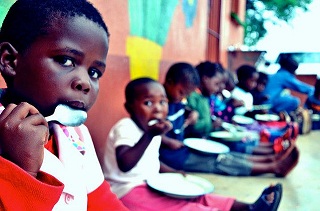Which countries will run out of food first?
 Living in a country like the U.S., where most people struggle with limiting their food consumption, it’s hard to imagine a life where you don’t even have the option of accessing enough calories for health.
Living in a country like the U.S., where most people struggle with limiting their food consumption, it’s hard to imagine a life where you don’t even have the option of accessing enough calories for health.But The Economist Intelligence Unit’s new Global Food Security Index makes clear the existence of that reality. It shows that in the planet’s most food-poor countries, food availability for the average inhabitant falls over 300 calories shy of the recommended daily intake of 2,300.
The five countries with the greatest calorie shortage per capita are (ranked worst to least worst):
1.Congo (Democratic Republic)
2.Burundi
3.Haiti
4.Zambia
5.Angola
In the five countries with the greatest calorie excess the average person has over 1,300 more calories available than the recomended 2,300. Those countries are (ranked beginning with highest excess):
1.Austria
2.United States
3.Greece
4.Belgium
5.Italy
The US, Denmark, Norway and France came out on top for the overall Food Security Index. In addition to food availability, the index ranks countries on the affordability of food, as well as its quality and safety.
Interestingly, for most countries scoring high on the food security index, micronutrient availability remained a problem. France was the only country in the top ten for the overall index that also ranked in the top ten for micronutrient availability. The weak micronutrient scores appear to primarily come from limited the availability of vegetal iron in national food supplies.
The Economist Intelligence Unit argues for optimism:
Several of the sub-Saharan African countries that finished in the bottom third of the index, including Mozambique, Ethiopia, Rwanda and Nigeria, will be among the world’s faster growing economies during the next two years. Although still poor in absolute terms, rising incomes suggest that these countries may be in a position to address food insecurity more forcefully in coming years.
However, the volatility of a growing economy can also lead to increased food access risks. If a growing economy stimulates population growth without adding to the food sector, that could drive food stores even lower. And, when some people suddenly become increasingly wealthy, it can make them more likely to demand extra food, leaving the supply for the rest of the population even weaker.
Those numbers showing that a number of countries really don’t have enough food to feed everyone made me wonder, does the world as a whole have enough food to feed everyone? According to the World Hunger Education Service’s 2012 facts, it does:
World agriculture produces 17 percent more calories per person today than it did 30 years ago, despite a 70 percent population increase.
That’s enough for feed everyone on the planet at least 2,700 calories a day. However, we still have a dire shortage of solutions for distributing those calories to the people who need them.
You can return to the main Market News page, or press the Back button on your browser.

